Would you do it if you could turn an Amazon affiliate website producing a few thousand a month into a six-figure paycheck?
This is precisely what you can do if you decide to sell your profit-making website, and it’s exactly what a seller did with us over at Empire Flippers.
I will explain how this seller got $190,000 for his Amazon Affiliate website on our marketplace and how you could do the same.
By the end of this post, you will understand the exact process it takes to make a profitable website and sell it for a big payday.
How to Sell an Amazon Website TLDR
If you are in a hurry and don’t have the time to check our complete guide on selling your Amazon affiliate website, here are the sections we cover so you can go directly and read what interests you.
- Why the platform your Amazon Affiliate website is on matters
- How to prepare your business for sale
- Negotiating with potential buyers
- Why do and how to run a Buyer-Seller conference call
- Ways to maximize selling an Amazon affiliate website for the most profit
- Why using a business broker can significantly help you in selling your business
Table of Contents
Platform and Monetization Method
The first thing to note when selling sites:
The platform and monetization do matter.
It would be best if you had something easy to hand off because a well-established site will be much more attractive to a prospective buyer.
For example, WordPress is a platform almost everyone understands, as 22% of US-registered domains run on WordPress.
If not, there are plenty of free resources and tutorials to make anyone a WordPress expert quickly. In addition, the monetization method for this site — the Amazon Affiliate program –– is pretty simple to grasp.
Using Amazon Affiliate as a monetization strategy is more accessible for people to understand than other affiliate programs.
Almost everyone is familiar with Amazon’s brand and can instantly relate to the fact that Amazon has built a trustworthy name that people respect and buy from.
If this Amazon Affiliate website had been built on Joomla – this site would be a lot harder a sale, though not impossible.
The reasoning isn’t only because Joomla is less reputable; it isn’t used as widely as WordPress, so fewer people are familiar with it.
Whatever platform you use, the key is ensuring the business you’re trying to sell has systems and processes to make it as plug-and-play as possible.
Once that business starts creating a proven track record as a solid profit earner, you’ll be able to reap the rewards of the systems you’ve built and sell the website for a big payday.
Some of you out there might be shocked at this idea and think…
“Why do people sell profitable websites?!”
Well, the reasons are as varied as why anyone would sell anything.
This business, in particular, was pretty hands-off, as many Amazon Affiliate websites are, but there are always legitimate reasons for wanting to sell one’s business.
These might include taking that big lump sum of cash and investing it into real estate, another online venture, or just going on an extended, exotic vacation.
We’ve done an entire podcast episode on this subject if you want to learn more about the different seller profiles.
In the case of this Amazon Affiliate website, the seller wanted to take the influx of cash from the sale of his site to invest in offline real estate.
Considering the price he could sell it for, that cash could be the start of several investment properties or enough to pay off an entire house.
Not a bad deal for an Amazon Affiliate website!
The Road To $161,500 In Net Profit
The Amazon Affiliate website was in the home and garden niche and had been created just the year before the sale in 2014. In the first month of the new year, the seller listed with us and submitted the website to our internal vetting process.
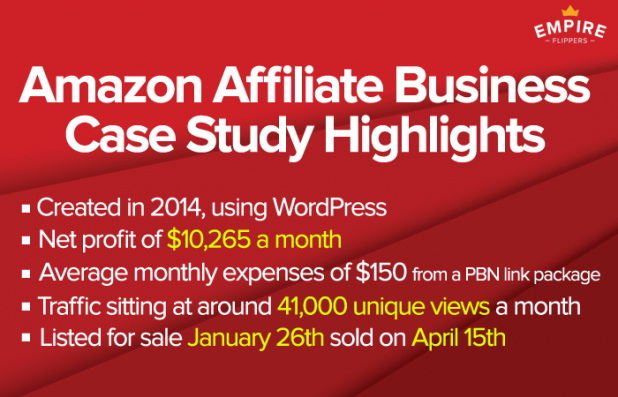
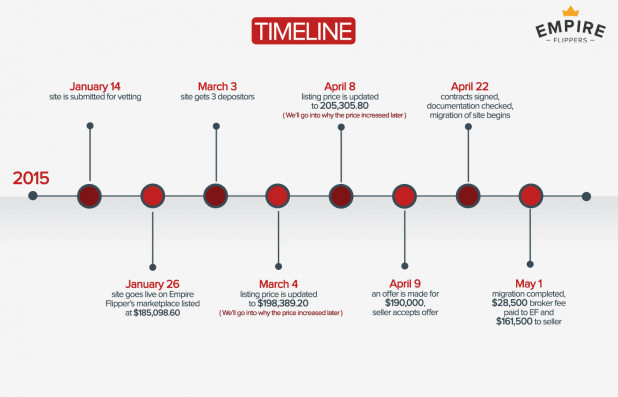
The website had one big piece of content reviewing multiple items in its niche. Everything led to its review to gain more search traffic.
Within the main piece of content they:
- Deep dive into common issues that people have with the products
- How to fix specific minor problems
- How to make a proper product selection
- The most significant benefits of choosing the right product for the task
This highly optimized piece of pillar content sat just under 3,000 words…
Then was supported by articles in the sidebar that was between 500-800 words on their own with 22 pieces of content.
The sidebar of the WordPress site was filled with several buying guides, along with their top reviews of various products within the niche that sat around 500-700 words each.
All of this led to having an extremely high-quality content website that did more than pass traffic through an Amazon affiliate link but offered solid value to the readers looking to purchase these high-ticket items.
Through the vetting process, we gave the business a valuation, listed the website on our marketplace, took in deposits, negotiated with prospective buyers, and eventually helped the seller and the buyer to come to a mutually satisfactory agreement.
Earning $161,500 in 110 days is an impressive feat for almost anyone, especially when this website made just over $10,000 a month WHILE it was listed with us.
Not too shabby.
Preparing & Listing The Website For Sale
Buyers’ confidence in our vetting process is crucial to the value you get at Empire Flippers.
In this case, as in every case, we ensured the site was valued correctly so that both seller and buyer got the fairest deal possible.
Assessing Analytics & Income
As a preliminary step, we had the seller forward their Profit & Loss statements (P&L) for the business and screenshots of both traffic and earnings.
However, we don’t just rely on screenshots. Instead, we log in to their traffic analytics and earnings accounts.
This seller used Clicky Analytics instead of Google Analytics. While Google is better known, Clicky is still a highly regarded analytics company.
The website was built on a Private Blog Network (PBN) to appeal to Google’s ranking algorithm, so it has done quite well in search rankings.
The nice thing about PBNs is that the website will rank. If it ranks and the content is good enough, the website will often start earning natural links from the exposure.
As you can see below, the Clicky Analytics were solid, with the traffic maintaining a steady pattern.

Traffic is only part of what we look at in the vetting process. Where the rubber meets the road is the earnings.
Since this site was monetized via an Amazon Affiliate account, verifying the earnings from the area was easy.
The seller used a specialized tracking ID for this website specifically to keep all the earnings organized. This was their last screenshot before the site sale, and it shows the Amazon affiliate commissions sitting at just over $11,000.
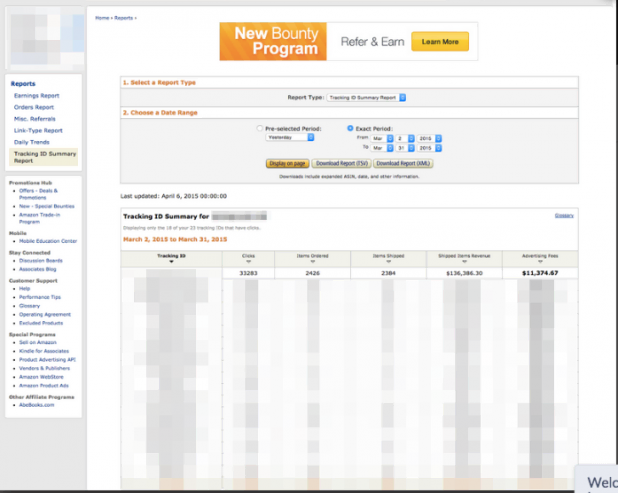
Here is the P&L that the seller submitted. This shows us a good overview of where the website started, where it was at the time the owner was interested in selling, and any trends we needed to be looking into during our vetting process.
Expenses and Potential Issues
You might notice we haven’t included the hosting and domain renewal fees, as these are fairly negligible. Also, you will notice no costs for content here. The reason is that the seller had left the site alone for several months, adding zeros pieces of content and letting the current organic traffic increase sales as the rankings went upwards.
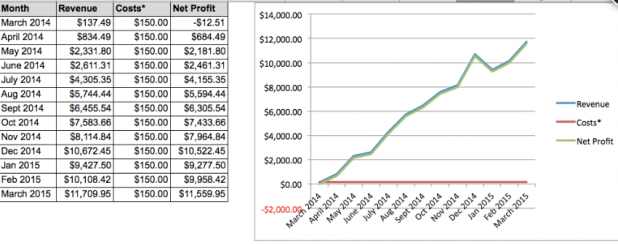
As we dug through this website’s vetting process, our agents encountered a discrepancy.
It appeared someone had been attempting to create a copycat version of the seller’s site. Using Copyscape, we found that about 61 percent of content was copied from the seller’s content on their website.
The content was brand new and contained some apparent copy-and-paste content theft from the seller’s website. This duplication of material presented a real problem, as it’s well known that Google’s ranking algorithm doesn’t like duplicate content. Our agents suggested that the seller either contact the domain owners of the websites that had copied him (we provided the names easily enough with a simple WhoIS search query) or revise portions of his content to make it more unique.
Ultimately, the problem was fixed quickly by revising some of the content.
Post-Sale Support
When asked what kind of support the new buyer would get from the seller, the seller was willing to give 30 days of email support. In addition, the new owner suggested a price of $150 a month for link maintenance to the new owner to keep all the PBN links the same.
This expense was worked into the final valuation of the site as well.
Negotiating A Price
The final valuation for the site was given with a listing price initially at $85,234.20 using a 12-month average of the site’s earnings. This pricing was due to the seasonal nature of the website’s traffic and income, which made its productivity less consistent. However, the seller argued for a three-month average to be used instead because links had been added over the preceding 12 months that had stabilized and increased the site’s productivity.
He felt, therefore, that the preceding three months were a more accurate reflection of the site’s value. Upon further vetting the website, our agents determined that the seasonal fluctuations were minimal. Ultimately, the three-month average better reflected the site’s stability and earnings.
Considering this, Empire Flippers listed the site at $185,098.60.
However, this was not the end of the negotiations.
The seller also pointed out that, given the high traffic volume and sales, the site moved through Amazon. The buyer could instantly increase all of the earnings on her already existing Amazon sites because the buyer’s newly acquired site would push them into the highest Amazon Affiliate tier of 8 percent.
This is something to remember when you go about selling or buying sites.
As time passed, it became clear that the seller had been correct when they stated there would be very little seasonal fluctuation to consider.
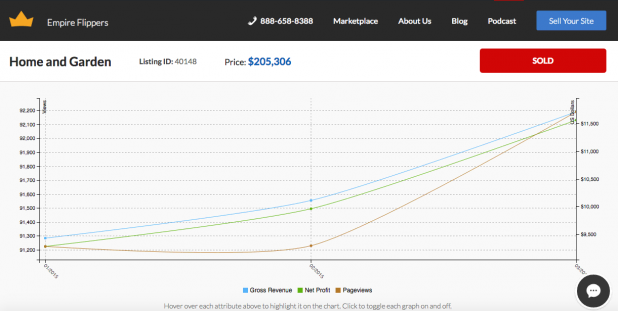
The website kept trending upward over the next couple of months. Empire Flippers readjusted the listing price until the final listing price on our marketplace was $205,305.80.
On the Market
During this time of increasing revenue, more prospective buyers appeared. Some submitted deposits and were therefore allowed to take a closer look and check out the website’s viability.
A deposit system is used on our marketplace instead of a Letter of Intent (LOI) option because it allows more buyers to do due diligence at once instead of waiting for an LOI exclusivity to run out (typically 30 days).
An LOI can drastically increase the sales cycle, so deposits are our preferred method.
The other benefit to the seller of our deposit system is that people who put down money to see these websites are typically severe buyers.
This isn’t the case with an LOI which allows fraudsters to PhotoShop their bank account statements, fill out the LOI and see whatever website they want to copy its successful model.
With the site listed and legitimate buyers’ interest peaked, we moved to the next part of the process: cutting a deal.
Negotiations & Closing The Deal
The serious buyer’s first point of contact was with our deal agents using the Zendesk ticketing system (a customer support software we use to help manage all customer service conversations).
This contact method protected the seller’s time while allowing Empire Flippers to field any low-level questions and move the serious buyers towards a potential sale.
Fielding Concerns About PBNs
One thing that concerns many sellers is whether their website will be devalued by using a Private Blog Network (PBN) to rank the site. This is understandable since a minority of buyers are hesitant to buy websites that have PBNs attributed to them.
While it is understandable to be extra careful buying websites built off PBN services, this was a case where the seller actually built his own PBN to rank this site along with other money sites in their portfolio.
One of the seller’s offers to potential buyers is that he would be more than happy to keep the links pointing toward the website for a small monthly fee. This cost was also put into the total price of the website as an expense.
If you are wondering what to do when a potential buyer looking at your business raises questions about the PBN you used, our seller’s response might be a perfect answer when you decide to sell your business.
The screenshot below shows the seller’s response to the buyer from our Zendesk ticketing system. We communicate via Zendesk to keep everything organized, and the sales process goes smoothly.
Check out the response below:

As you can see, this prospective buyer asked some excellent questions, and the seller gave excellent answers.
How to dilute the PBN importance?
By ranking on the first page of Google for keywords, the seller garnered more attention from other website owners and scored natural links through exposure and high-quality content.
This diminished the need for the PBN links overall, and as time went on for the website, the PBN links became less and less critical to the actual rankings of the website.
This question came in from a different prospective buyer as the deal started to close with a buyer with serious intentions.
An initial offer was made for $190,000, which was $25,000 below the asking price but still $5,000 above the initial listing price we had listed on our marketplace.
Buyer-Seller Conference Call
This led to a buyer-seller conference call.
These calls are crucial in negotiations for sites above the six-figure range.
While many sites below the $50,000 mark will sell almost “automatically” due to the large pool of hungry buyers, sites above $50,000 and into the six-figure range require a more intimate sales process.
That is precisely why we facilitate these buyer-seller conference calls.
Our deal consultant reaches out to the seller to set up a time for them to get on the phone with the buyer. Before the call takes place, the deal consultant coaches the seller on anything they need to know about the buyer, such as the buyer’s goals or personality type.
The deal consultant is always present on these calls to make both the seller and the buyer more comfortable and to mediate between the parties.
Managing The Unexpected
One thing that the prospective buyer was concerned about was whether the domain was clean.
It turned out that the domain was used before the seller registered it for their Amazon Affiliate website.
Upon further research, we found out that in 2005 and 2006, the domain was once used as part of a “Parked Domain Monetization Method.”
This was an old-school way of making money from ads displayed on parked domains with no actual content, but because of the domain name, there was a bit of direct traffic from people actively typing in that domain name.
This was a pretty hyped-up strategy in the mid-2000s, though very few people find themselves doing it anymore because there are many better ways to monetize a site property.
The seller confirmed that the domain was new to them and under this control since December 2013. Due diligence revealed that the environment was clean of anything unsavory regarding SEO.
After this initial concern, another issue arose regarding the buyer’s dealings with the Amazon affiliate links. They wanted to ensure the seller would transfer all affiliate links to their Amazon account.
Usually, this process can be pretty tedious for both the seller and the buyer. Still, since they were using our brokerage, we were able to mitigate the frustrating process of migration.
Our deal consultant informed the buyer that our agents are specifically trained to migrate sites from an old owner to a new one.
The migration service included changing all affiliate links to the buyer’s account and pushing the domain to the new owner’s registrant account and hosting account.
Closing the Deal
Thanks to the buyer-seller conference call, the buyer and seller got to know each other, which put both parties at ease and made them more open to proceeding with the deal.
In this case, the buyer was a strong candidate, and our deal consultant advised the seller to agree to the $190,000 offer.
The seller agreed, and both parties signed a purchase agreement.
Empire Flippers began migrating the site to the new owner.
Post-Sale Transfer & Turnover Process
We opened a new ticket from here, and our migration specialists began transferring the site to the new owner. They gathered both the buyer’s and the seller’s hosting login details.
Amazon account
Since it was an Amazon Affiliate website, our agents also instructed the new buyer to set up an Amazon Affiliate tracking ID code specifically for this website in their Amazon Associates account.
Hosting
Due to the site’s high traffic volume, the seller used a VPS hosting solution that the website received from Google. The seller recommended that the new buyer continue using a VPS and create a new registrant account as the specific domain registrar the seller used.
Since the seller’s hosting situation was unusual, the seller helped by migrating the site hosting to the new owner.
In addition, since the seller decided to keep the PBN they used, the buyer negotiated a deal in which they could continue to rent the links on the PBN pointing to the site.
This was included in the site’s expenses and set up using a recurring credit card payment on the buyer’s side.
Ultimately, the site migration was a complete success.
Release of funds
As the brokers of these deals, we do our best to represent both sides and make sure both parties walk away with a win-win situation. And letting the money flow is precisely what we did.
Since the buyer was comfortable with the migration and had reported correct traffic numbers and earnings, we released the funds to the seller for a total of $161,000 after our brokerage fee.
That is over three times a US citizen’s average yearly income. Not too bad for an Amazon Affiliate website; remember, this is just ONE site.
This seller had several sites in the pipeline, positioning them all for their paydays down the road as they ranked, gathered traffic, and began to be successfully monetized.
How To Sell Your Amazon Affiliate Website
To put yourself in a great position to sell your Amazon affiliate site for the maximum profit, you must keep track of some valuable figures. Having an up-to-date record of expenses and analytics will work massively in your favor when speaking to potential buyers.
If you’re wondering how to copy this seller’s success, follow these rules.
Track Expenses
The very first step for successfully selling an Amazon affiliate website is making sure you track ALL expenses. Keep these separate from personal expenses. These expenses might appear in content, buying PBN sites, renting out links, or many other ways.
It is essential to be clear on what kind of expenses your website produces so that future buyers can know what it took to grow the site and any ongoing costs they will have to pay once they take over the website.
In addition, you should maintain a monthly Profit & Loss statement (P&L for short). This is just good practice and will let the potential buyer see the trajectory of the website in a quick snapshot.
While it is a big hassle to go back and create a P&L, it is easy to make updating a P&L spreadsheet part of your monthly work on the website.
(Plus, watching the profits displace the losses is inspiring and will increase your drive to work on the site.)
Analytics
Along with keeping a solid record of earnings and expenses, you should have some analytics installed on your website from day one.
This could be Google Analytics, or if you lean more on the paranoid side, you could use a third-party service such as Clicky to track how many visitors your site gets every month.
The more data you have on this, the better because a buyer will be very interested in any dips or increases in traffic. This data will allow them to see if your website is overall trending upward or downward month after month.
Speaking of dips and spikes of traffic, when you see fluctuations in your analytics, ask yourself why it happened. Did you try a new advertising method?
Did you pick up brand-new links? Or is the website just doing the Google Dance?
It is essential to explain these as many buyers will be curious.
Not having the answers to these could be the make-or-break question depending on the buyer. It is best to be prepared — keep an Excel spreadsheet of the dips and the spikes with a brief explanation of why they happened according to your analyses.
Like the P&L statement, this is easiest to do by just staying on top of it and noting these spikes or dips as part of your monthly work on the website.
It will be much easier than reviewing all your analytics later and remembering what happened on that specific week or month.
Collecting this data will help you sell your business at a higher multiple more quickly. You should have three solid months of good earnings and traffic at the very least.
Of course, the longer the solid earnings and traffic trend, the better your website will sell on our marketplace.
Systemize
The next thing you will want to implement on your website is a form of systemization.
Systemization is taking every task you perform on the site and turning it into a repeatable process.
For example, you might have a certain way you hire content writers for your site. Write down this hiring process, what you look for in the article, or even brief outlines of different types of essays (such as social clickbait articles, SEO articles, how-to, etc.). The more you can put systems and processes into place, the more attractive the business becomes.
When a buyer is looking at a potential business, especially one they may not be familiar with, it is best to demonstrate as many plug-and-play portions as you can…
This will make the buyer feel more comfortable with their investment choice and confident in their ability to run the site effectively.
Finally, while you can sell a website privately and avoid a brokerage fee, it is not recommended (and I’m not saying that just because of my obviously biased opinion).
Benefits of using a professional broker
There are a lot of pros to using a broker that many sellers don’t realize until they try to sell a website on their own — which can be an incredibly frustrating process if you are not familiar with how deals are structured.
Benefits of using a professional business broker that understands online businesses:
- Buyer Reach: Most private sellers struggle finding buyers, and often they are unqualified buyers that give them lowball offers. One difference we make for our sellers is that we have a list of over 30,000+ potential buyers.
- Negotiation: This is a problem that ails a lot of sellers and can seriously lower the price at which they end up selling their business. A trained deal consultant that sees hundreds of deals is going to be able to represent you far better.
- Migration: Not all brokers do this, but it is something that we take care of at Empire Flippers for our customers. Migration can be incredibly tedious, like changing all the affiliate links, hosting, etc.
- Security: Having a third party overseeing the deal, significantly one trained and experienced with online businesses, can help avoid a scam or an underhanded deal.
- Time: Selling an online business for a big payday is not quick or painless. One reason the seller of this particular Amazon site chose us is that their time is at a premium, and we took that burden off the seller.
Those are just a few reasons why using a professional broker can be extremely helpful in aiding the sale of your site.
Hopefully, you are pretty pumped about selling your Amazon affiliate website or other online business by this point.
Would you sell your website?
As you can see, there is a lot of profit to be realized upfront with an asset sale like this, and there is a hungry market of online business buyers who are prepared to spend well into the six-figure range.
If you are ready to see how big of a payday you can get for your website, the first step is to find out what your website is worth. No worries, and we have already built a tool to help you with this that you can use free of charge. Click here for our free valuation tool and see what your website is worth.
Wrapping It Up
As you can see, many moving parts exist to selling an online business.
You need to ensure all loose ends are tied up, that your traffic is good, that you can legitimately verify your earnings, and so much more.
Then there is the whole marketing portion of the sale – something most sellers do not have the capability, skills, or experience to pull off. That is especially true for higher-end sales like this one that are in the six-figure range.
One of the big benefits of using a good broker is that these frustrations are eliminated for the seller.
A professional brokerage will have ways to weed out tire-kickers from real, qualified buyers that can actually purchase your business.
As you can see, selling your Amazon affiliate website, or any website, can lead to a huge payday.
Where you literally earn 20-30 months’ worth of income all upfront, without having to wait around and worry that your Google rankings might fall off the chart or any other worries that keep us, online entrepreneurs, up at night with fear and stress.
Many of our sellers have become repeat sellers because of all this, and like this seller – they too have seen the money flow from the fruits of their efforts.
When you are ready to cash in on your business in a big way, you can check out the exact steps this seller went through to list his site with us by clicking here.
Guest post by Greg Elfrink
 Monetize.info We Help You Grow & Monetize Your Online Business!
Monetize.info We Help You Grow & Monetize Your Online Business!





![10 Ways To Find a Buyer for Your Online Business [With Examples]](https://monetize.info/wp-content/uploads/2024/04/10-Ways-To-Find-a-Buyer-for-Your-Online-Business-With-Examples-310x165.webp)
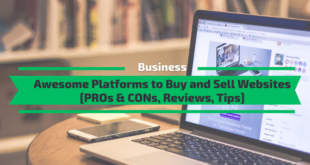

I’ve never really done well with Amazon but this has made me want to start again. What a great case study.
@Corinne. Thank you for stopping by. Indeed Amazon affiliate is not an easy-to-swallow pill, yet those who manage to do it right can get some nice profits. I recommend you also check our other tutorial about affiliate marketing https://monetize.info/how-to-start-an-affiliate-marketing-blog/
Personally, I’m not a big fan of Amazon Associates websites but I know folks that leverage it really well.
Any pointers to the actual marketplace listing and the bids received please? may be its trendy during 2015-2017 times and not anymore?